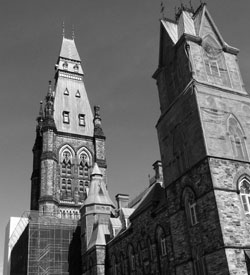Our House is Under Renovation

How do you preserve the spectacular stone architecture of treasured buildings such as those on Parliament Hill while making sure that, within their walls, elected Members have the tools they need to carry out the business of a 21st-century democracy?
Sound planning, a clear vision and uncompromising attention to detail all come into play to ensure that the everyday work of Parliament proceeds uninterrupted while its historic precinct undergoes a critical rehabilitation.
For Parliament, Business as Usual
The Parliament Buildings and grounds are in the midst of a major upgrade and restoration program—the first part of the Long Term Vision and Plan for the Parliamentary Precinct. Phase One alone is a five-year program that includes planning and undertaking the restoration of the West and the East Blocks and upgrades to the Confederation Building, the Centre Block and parts of the grounds. The aim is to protect and restore these important elements of Canada’s architectural and democratic heritage while at the same time equipping them to support the activities of a modern Parliament.
As part of the Long Term Vision and Plan, appropriate interim space has to be provided for the relocation of parliamentary functions to allow major construction work to occur in the heritage buildings. Last year, the House Administration continued working closely with Public Works and Government Services Canada to make sure that, throughout the renovation process, Members, committees and caucuses have access to the facilities they need to carry out their work on the country’s behalf. The logistics had to be carefully managed. For example, Members had to relocate from the West Block to interim space within reasonable distance of Parliament Hill. In this new context, where parliamentary functions are dispersed in the city core rather than consolidated in a defined Parliamentary Precinct, the House Administration ensures that the activities of the House of Commons continue with no interruptions.
The House Administration also focused on developing the plans to ensure that when the West Block reopens, it will provide an appropriate temporary home for the functions currently carried out in the Centre Block—where the next round of renovations is planned.
Communication is Key
Parliamentarians and others on the Hill need to know how the Long Term Vision and Plan is unfolding and what changes to expect. Last year, the House Administration introduced a number of communications tools to keep them informed, including booklets on the new buildings and an e-bulletin for regular updates. At the beginning of 2011, the e-bulletin was replaced by a weekly Web page: LTVP – Construction within the Parliamentary Precinct.
Architecture is Not the Only Valuable Element
The Centre Block is currently home to 90 paintings spanning the period from 1854 to 2010. Plans were finalized in 2010–2011 to ensure the conservation of these pieces during the Long Term Vision and Plan activities and into the future so they will be available for the appreciation of generations to come.
Inside the Chamber — Highlights from 2010–2011
Aside from the Peace Tower, the Chamber is likely the most recognizable element of Canada’s Parliament. It is where elected Members come together to debate issues of national importance, and to introduce and discuss potential new laws.
Last year in the Chamber, 52 government bills were introduced on wide-ranging topics including gasoline prices, Criminal Code amendments with respect to white collar crime and pardon provisions, Canada consumer product safety, legislation on economic measures, enhancing the New Veterans Charter, the abolition of early parole, and dealing with the assets of foreign officials.
A total of 144 private Members’ bills were introduced on issues such as:
- Federal spending power
- Proactive Enforcement and Defect Accountability Legislation (PEDAL)
- Survivor’s annual allowance
- Air passengers’ bill of rights
- Poverty elimination
- Protecting Canadians abroad
- Status of Women Canada
- First Nations education funding plan
- National public transit strategy
- Protecting beneficiaries of long-term disability benefit plans
During all these activities, the Chamber was presided over by then-Speaker of the House, the Honourable Peter Milliken—who set a new record during the 40th Parliament as the longest-serving Speaker in Canadian history.
Other Chair Occupants for the 40th Parliament, 3rd Session
Andrew Scheer, Deputy Speaker and Chair of Committees of the Whole
Denise Savoie, Deputy Chair of Committees of the Whole
Barry Devolin, Assistant Deputy Chair of Committees of the Whole

“I work with a small, dedicated group of specialists responsible for the preservation, management and interpretation of the 8,000-some objects that make up the heritage collection at the House of Commons. I think all employees of the House function, in their own ways, as stewards of the institution, maintaining its integrity and dignity as the focal point of Canadian democracy.”
– David Monaghan
Curator
Curatorial Services
Parliamentary Precinct Services
